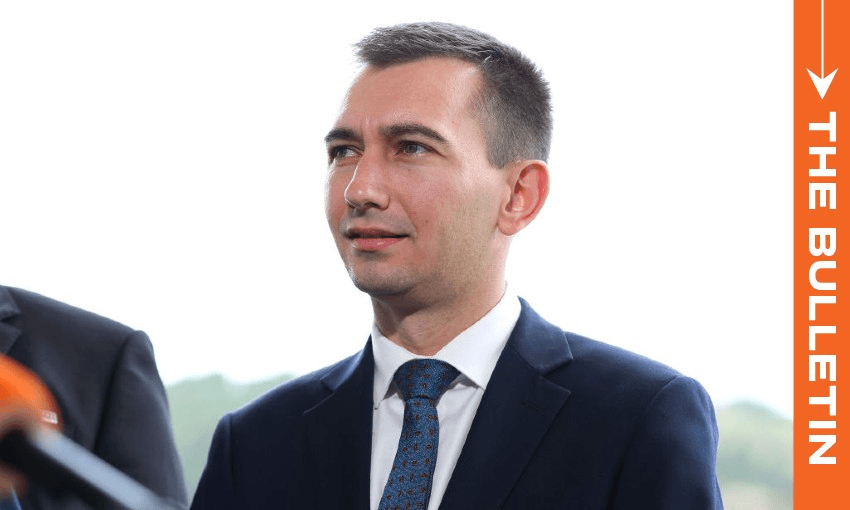Nobody likes a bumpy road and nobody is arguing for more potholes, writes Stewart Sowman-Lund in today’s extract from The Bulletin.
To receive The Bulletin in your inbox every weekday morning, sign up here.
A boost for roads
We’ve talked a lot about transport in recent weeks – from policies to target drunk drivers to the possible end of fuel excise tax (and maybe Auckland Transport as an organisation, too). It’s clear that the tail end of the government’s ongoing quarterly action plan has been dedicated to a flurry of costly infrastructure announcements, much of which were foreshadowed during the election campaign. Yesterday, reported the Herald’s Thomas Coughlan, another swathe of announcements were unveiled by transport minister Simeon Brown in the form of the latest National Land Transport Programme, which sets out where the transport agency spends its budget. It carried with it a price tag of nearly $33bn over the next three years, about $8bn more than what was allocated under the previous government. None of it is a surprise, given it lines up with priorities already released by the government. A significant amount of the budget – $7bn – has been earmarked for 17 new “roads of national significance”. And, as has been a consistent them of the government’s commentary since the election, there’s funding for road maintenance too.
Why the fixation on fixing potholes?
The latest action plan forecasts a $6.4bn investment in fixing potholes, with $4.6bn for road maintenance operations. It’s no coincidence that parties in opposition tend to fixate on issues, like pothole repairs, that from the outside can seem a bit trivial. In short, nobody likes a bumpy road and nobody is arguing for more potholes. This report from the United States doesn’t go quite as far as claiming that fixing potholes is an election winner, but it does suggest some correlation between the number of potholes in a particular area and the number of votes an incumbent candidate receives. “We find consistent evidence that more potholes in individual neighbourhoods result in fewer votes for incumbent… officials,” wrote the researchers, though noting that it’s a conclusion that doesn’t capture the full picture around where votes go. The recent UK election offered another example of potholes as an election issue, with the (since elected) Labour Party announcing a pledge to fix a million of them every year. This piece in The Conversation said that election campaigns often seek to give the “feeling” of improved infrastructure, pointing out that Labour’s promise risked distracting from “the meaningful investment that England’s infrastructure so desperately needs”.
In New Zealand, wrote The Spinoff’s Shanti Mathias last year, complaining about potholes has been something of a national pastime for over a century. And given rain is a major contributor to them forming in the first place, don’t expect that to stop even if the government is intent on filling them in.
Auckland a big winner
In pure financial terms, Auckland comes out on top in this latest funding commitment – over $8bn will be spent in the super city alone, said Simeon Brown, with $3.7bn of that to improve public transport services. All up, that’s about a quarter of the overall investment and will include starting work on three roads of national significance (though these won’t be completed in the three-year term). In per capita terms, as this graph by the Greater Auckland group shows, investment in the South Island is lagging behind. Though some projects – such as a replacement Pages Road bridge in Christchurch – have secured financing.
Very quick per capita spend by region in the just published NLTP. Yes the South Island really is missing out. pic.twitter.com/1fvLPV6k3p
— Greater Auckland (@GreaterAKL) September 2, 2024
All of these projects are costly and time consuming. Politik’s Richard Harman (paywalled) queried what might happen if costs inflated beyond what has been set aside, noting that Brown has indicated an interest in “public-private partnerships” to help get extra money into the transport agency. Whether that eventuates remains to be seen.
Active transport a big loser
One area the latest round of transport funding noticeably lags is in walking and cycling infrastructure. In money terms, the budget for these projects has roughly halved – down to about $460m. Simeon Brown described these as “nice-to-haves”, reported RNZ, echoing the language used by his boss Christopher Luxon to describe so-called “white elephant” projects devised by local councils. The new land transport programme was about getting “back to basics”, said Brown, again using language that would fit nicely on a National Party brochure. “There’s less money going into cycleways, and I think New Zealanders are sick and tired of the amount of money going into cycleways,” said Brown. The opposition is unimpressed, reported RNZ’s Russell Palmer, with Labour’s Tangi Utikere accusing the government of “putting all its eggs in one basket” and underinvesting in areas like rail transport, with the Greens’ Julie Anne Genter saying people will be forced to rely on their cars due to a lack of alternatives.
Speaking to Heather du Plessis-Allan on Newstalk ZB, Brown said that roading was “front and centre” of the budget and took aim at an “infestation” of speed bumps, which would have no extra money allocated. In The Post this morning, Amelia Wade looks at a claim by the transport minister that stopping 24 speed bumps would save $12m – a claim the Greens have labelled “demonstrably untrue”.
